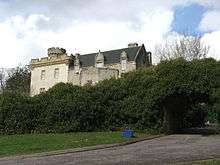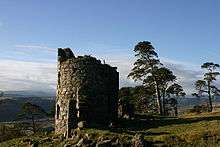Tulloch Castle
.jpg)

Tulloch Castle is located in the town of Dingwall in the Highlands of Scotland. It probably dates to the mid 16th century. Over the years, it has served as a family home for members of the Bain family, Clan Davidson, and Vickers family. The castle was used as a hospital after the evacuation of Dunkirk, and then as a hostel for the local education authority. It is currently used as a hotel and conference centre.
History
Tulloch Castle likely dates to the mid 16th century, when Duncan Bane (Bain, Bayne) was granted the barony of Tulloch in 1542.[1]
In the 18th century however, ownership of the castle changed hands. Kenneth Bayne, 8th Laird of Tulloch, sold the estate to his cousin, Henry Davidson, in 1762.[2] On Henry's death in 1781 Tulloch was inherited by his younger brother Duncan Davidson, who was MP for Cromartyshire from 1790 to 1796.[3] He was in turn succeeded by his son Henry (1771–1827), grandson Duncan (1800–1881) and great-grandson Duncan Henry Caithness Reay Davidson (1836–1889),[4] who was the father of the last Davidson of Tulloch, Duncan (1865–1917).[5] The castle was damaged by fire in 1845, and extended in 1891.[6]
The castle passed out of Davidson ownership in 1917 when Duncan Davidson died and left the castle to his daughter and her son, Colonel Angus Vickers, of the Vickers aircraft company. Architect Sir Robert Lorimer designed alterations in the early 1920s.[7] After serving as the Vickers' family home for several years, and as a hospital for casualties of Dunkirk in 1940, Tulloch Castle was purchased by the local education authority in 1957. It was used as a hostel for students from the west coast of Scotland who were studying at Dingwall Academy until 1976. After this, the castle fell into disrepair until it was renovated and converted into a hotel by local family, the MacAulays, in 1996. It remains in use as a hotel and conference centre,[8] and played host to the official Clan Davidson Gathering in October 2007.[9] It is a category B listed building.[7]It was Phyllis Vickers who in 1994 inherited the Barony by her uncle Angus Vickers. Dr. David Willien of Tulloch has inherited in turn the title and caput of the barony.
Supernatural reports
Tulloch castle is said to be haunted by a green lady and other ghosts [10]. These supernatural claims were explored in the Grampian Television series Beyond Explanation in 2005 [11]. On 28 May 2008 it was reported that a 14-year-old boy named Connor Bond apparently took a photograph (with a digital camera) of a "hand" holding on to the stair railing with an apparition floating behind it [12].
The grounds and estate

Tulloch Castle has many interesting features. A tunnel runs from the basement of the castle under the town of Dingwall to the old site of Dingwall Castle. The tunnel has now collapsed, but it is possible to view this passageway through an air vent on the front lawn of the castle’s grounds. There is a Davidson cemetery in the grounds of the castle for family members and pets. The graveyard is surrounded by a metal fence and has become overgrown, though some of its headstones are still visible. Originally, there were two walled gardens on either side of the castle. These are now overgrown and parts of them have become woods or have had houses built on them. The castle had two gatehouses and entrance paths. The former west gatehouse was situated at the foot of what is now Maggie's Drive and can be seen on old postcards of Dingwall and also OS maps from the late nineteenth and early twentieth century. Though the west gatehouse no longer exists the east gatehouse has survived and is currently a privately owned house. This gatehouse was built in 1876 and the path which connects it to the castle has become a public road. This road is still used as the main entrance to the castle today.
On a hill to the north of the castle stands "Caisteal Gorach", a late 18th-century folly which was designed by Robert Adam for Duncan Davidson of Tulloch. The folly comprises a ruined round tower and flanking walls, and is a category A listed building.[13]
References
- ↑ Scottish Castles Association. "Tulloch Castle at the Association for Scottish Castles". www.scottishcastlesassociation.com. Retrieved 17 June 2012.
- ↑ Rennie, James Alan (1960). The Scottish People: Their Clans, Families, and Origins. London: Hutchinson. p. 119. Retrieved 8 January 2017.
- ↑ David R. Fisher, DAVIDSON, Duncan (1733-99), of Tulloch, Ross and Myles's, Ongar, Essex. in The History of Parliament: the House of Commons 1790-1820 (1986).
- ↑ David R. Fisher, DAVIDSON, Duncan (?1800-1881), of Tulloch Castle, Dingwall, Ross. in The History of Parliament: the House of Commons 1820-1832 (2009).
- ↑ Charles Mosley, Burke's Peerage, 107th edition (2003) vol. I, p. 1049, cited in Darryl Lundy, Duncan Davidson of Tulloch, thepeerage.com. Accessed 11 February 2013.
- ↑ Coventry, Martin. "Tulloch Castle". Retrieved 24 January 2018.
- 1 2 "Tulloch Castle and arched tunnel entrance LB24518". Historic Environment Scotland. Retrieved 24 January 2018.
- ↑ "Tulloch Castle Hotel". Bespoke Hotels Ltd. Retrieved 24 January 2018.
- ↑ "2007 International Gathering at Tulloch Castle". Clan Davidson Association. Retrieved 24 January 2018.
- ↑ "Four haunted castle hotels to head to for a spooky Halloween". GlasgowLive. Retrieved 22 May 2018.
- ↑ "Tulloch Castle". Haunted Scotland. Retrieved 22 May 2018.
- ↑ "Halloween in Scotland: The most haunted locations in the country". Daily Record. Retrieved 22 May 2018.
- ↑ "Tulloch Castle, Caisteal Gorach LB24520". Historic Environment Scotland. Retrieved 24 January 2018.
- Tulloch and The Lands brochure
External links
| Wikimedia Commons has media related to Tulloch Castle. |